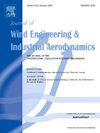考虑不同国家标准的铁路车辆横风稳定性比较研究
IF 4.2
2区 工程技术
Q1 ENGINEERING, CIVIL
Journal of Wind Engineering and Industrial Aerodynamics
Pub Date : 2024-09-26
DOI:10.1016/j.jweia.2024.105901
引用次数: 0
摘要
考虑到不同国家标准在准静态和非静态风条件下(如中国的阵风(EN 14067-6,2010 年))对铁路车辆的横风稳定性进行了系统评估。初步观察发现,日本提出的准静态分析(QSA)略微低估了铁路车辆车轮卸载率约 3%,原因是忽略了垂直自由度,且无法准确评估垂直防撞装置的激活情况,因此在准静态风条件下,外力增加超过了一定临界值。随后,为了准确评估铁路车辆在现实条件下的横风响应,提出了一个非线性横向加速度模型,以考虑轨道不规则性的影响,并根据现场测试数据进行了验证。最后,需要指出的是,中国标准更为保守,其特征风速(CWC)比欧洲标准低约 2 米/秒,而日本准则在列车高速行驶时更为严格,但在低速行驶时更为宽松。在阵风条件下评估的 CWC 比准稳定风条件下的 CWC 高出约 2.4 米/秒,这是因为最大阵风风速是通过居中移动平均法进行低通滤波的。本文章由计算机程序翻译,如有差异,请以英文原文为准。
A comparative study on the crosswind stability of the railway vehicle considering distinct national standards
The crosswind stability of railway vehicles, considering distinct national standards in both quasi-steady and unsteady wind conditions, like Chinese hat gust wind (EN 14067-6, 2010), is systematically evaluated. Initially, it is observed that the quasi-static analysis (QSA) proposed in Japan marginally underestimates the wheel unloading ratio of railway vehicles by approximately 3 %, as the external forces increase beyond a certain threshold in quasi-steady winds due to the neglect of the vertical degree of freedom and the inability to accurately evaluate the activation of vertical bump stops. Subsequently, to accurately assess the crosswind responses of railway vehicles under realistic conditions, a non-linear lateral acceleration model is proposed to account for the effects of track irregularities, validated against field test data. Finally, it is noted that the Chinese standard is more conservative, with characteristic wind speeds (CWC) approximately 2 m/s lower than those calculated by the European standard, while the Japanese guideline is more stringent at high train velocities but more lenient at low velocities. The CWC evaluated under gust wind conditions is around 2.4 m/s higher than those obtained under quasi-steady winds, due to the maximum gust wind speed is low-pass filtered by the centered moving average method.
求助全文
通过发布文献求助,成功后即可免费获取论文全文。
去求助
来源期刊
CiteScore
8.90
自引率
22.90%
发文量
306
审稿时长
4.4 months
期刊介绍:
The objective of the journal is to provide a means for the publication and interchange of information, on an international basis, on all those aspects of wind engineering that are included in the activities of the International Association for Wind Engineering http://www.iawe.org/. These are: social and economic impact of wind effects; wind characteristics and structure, local wind environments, wind loads and structural response, diffusion, pollutant dispersion and matter transport, wind effects on building heat loss and ventilation, wind effects on transport systems, aerodynamic aspects of wind energy generation, and codification of wind effects.
Papers on these subjects describing full-scale measurements, wind-tunnel simulation studies, computational or theoretical methods are published, as well as papers dealing with the development of techniques and apparatus for wind engineering experiments.

 求助内容:
求助内容: 应助结果提醒方式:
应助结果提醒方式:


